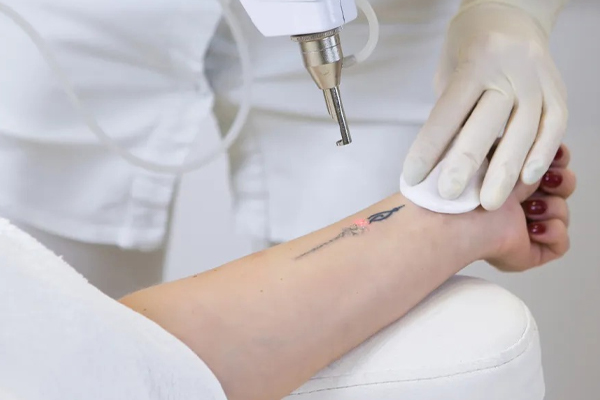Tattoo removal
Tattoo removal is the process of fading or completely removing unwanted tattoos using various methods to restore smooth skin.
Methods of Tattoo Removal
-
Laser Tattoo Removal
- Most common and effective method.
- Uses different wavelengths to target and break down tattoo ink.
-
Dermabrasion
- Physically scrapes off the top layers of skin along with the tattoo ink.
-
Chemical Peels
- Removes skin layers containing tattoo ink through chemical exfoliation.
-
Microneedling with PRP
- Utilizes microneedles to stimulate skin regeneration, which can fade tattoos over time.
Benefits of Tattoo Removal
- Removes unwanted tattoos for a cleaner, smoother skin surface.
- Minimal risk of scarring when performed by a skilled professional.
- Can improve skin texture and appearance after removal.
- Reduces emotional distress associated with visible tattoos.
Procedure Overview
1. Laser Tattoo Removal
- Types of Lasers:
- Q-switched Nd:YAG laser: Best for dark ink tattoos.
- Alexandrite and Pico lasers: Effective for all ink colors.
- Process:
- Laser targets ink particles and breaks them down into smaller pieces, which are then absorbed by the body.
- Sessions:
- Multiple sessions (4-8) are typically required, spaced several weeks apart.
2. Dermabrasion
- Process:
- Uses a rotating tool to remove the skin layers containing tattoo ink.
- Requires multiple sessions depending on tattoo size and depth.
3. Chemical Peels
- Process:
- Chemical solutions are applied to peel away layers of skin containing tattoo ink.
- Effective for superficial tattoos.
4. Microneedling with PRP
- Process:
- Microneedling creates micro-injuries to stimulate collagen, while PRP enhances healing and promotes fading of the tattoo over time.
Recovery Process
-
Laser Tattoo Removal:
- Swelling, redness, and mild discomfort immediately after treatment.
- Recovery takes 7-14 days per session.
- Results improve gradually with multiple sessions.
-
Dermabrasion:
- Temporary redness, scabbing, and mild discomfort.
- Recovery takes about 2-3 weeks per session.
-
Chemical Peels:
- Mild to moderate discomfort, followed by peeling and flaking skin.
- Recovery lasts 7-10 days per session.
-
Microneedling with PRP:
- Minimal downtime with mild redness and swelling lasting a few days.
Ideal Candidates for Tattoo Removal
- Individuals with unwanted tattoos looking for complete or partial removal.
- Those with realistic expectations regarding the number of sessions required.
- Healthy individuals with no skin conditions that may interfere with healing.
Risks and Complications
-
Laser Tattoo Removal:
- Risk of skin irritation, pigmentation changes, or scarring if not performed carefully.
- Mild discomfort during sessions.
-
Dermabrasion:
- Potential for scarring, infection, or skin irritation.
- Requires careful post-care to avoid complications.
-
Chemical Peels:
- Possible skin irritation, temporary sensitivity, and pigmentation changes.
-
Microneedling with PRP:
- Rare risk of infection or scarring with improper post-procedure care.
Cost Factors
- Size and complexity of the tattoo.
- Number of sessions required.
- Type of treatment (laser, dermabrasion, chemical peel, etc.).
- Expertise of the specialist performing the removal.



